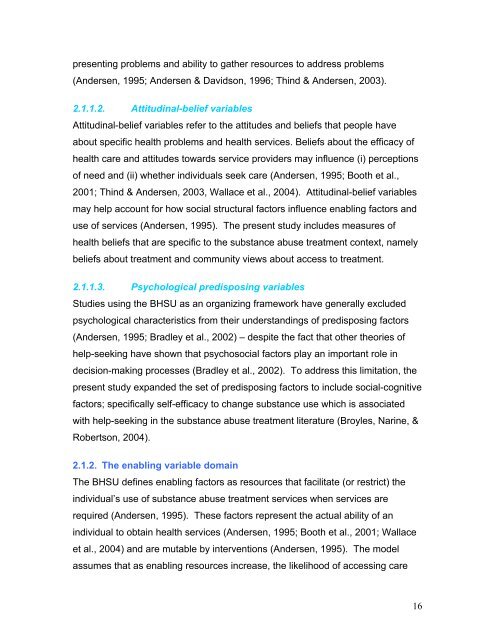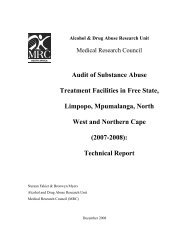Access to substance abuse treatment in the Cape Town metropole ...
Access to substance abuse treatment in the Cape Town metropole ...
Access to substance abuse treatment in the Cape Town metropole ...
Create successful ePaper yourself
Turn your PDF publications into a flip-book with our unique Google optimized e-Paper software.
present<strong>in</strong>g problems and ability <strong>to</strong> ga<strong>the</strong>r resources <strong>to</strong> address problems(Andersen, 1995; Andersen & Davidson, 1996; Th<strong>in</strong>d & Andersen, 2003).2.1.1.2. Attitud<strong>in</strong>al-belief variablesAttitud<strong>in</strong>al-belief variables refer <strong>to</strong> <strong>the</strong> attitudes and beliefs that people haveabout specific health problems and health services. Beliefs about <strong>the</strong> efficacy ofhealth care and attitudes <strong>to</strong>wards service providers may <strong>in</strong>fluence (i) perceptionsof need and (ii) whe<strong>the</strong>r <strong>in</strong>dividuals seek care (Andersen, 1995; Booth et al.,2001; Th<strong>in</strong>d & Andersen, 2003, Wallace et al., 2004). Attitud<strong>in</strong>al-belief variablesmay help account for how social structural fac<strong>to</strong>rs <strong>in</strong>fluence enabl<strong>in</strong>g fac<strong>to</strong>rs anduse of services (Andersen, 1995). The present study <strong>in</strong>cludes measures ofhealth beliefs that are specific <strong>to</strong> <strong>the</strong> <strong>substance</strong> <strong>abuse</strong> <strong>treatment</strong> context, namelybeliefs about <strong>treatment</strong> and community views about access <strong>to</strong> <strong>treatment</strong>.2.1.1.3. Psychological predispos<strong>in</strong>g variablesStudies us<strong>in</strong>g <strong>the</strong> BHSU as an organiz<strong>in</strong>g framework have generally excludedpsychological characteristics from <strong>the</strong>ir understand<strong>in</strong>gs of predispos<strong>in</strong>g fac<strong>to</strong>rs(Andersen, 1995; Bradley et al., 2002) – despite <strong>the</strong> fact that o<strong>the</strong>r <strong>the</strong>ories ofhelp-seek<strong>in</strong>g have shown that psychosocial fac<strong>to</strong>rs play an important role <strong>in</strong>decision-mak<strong>in</strong>g processes (Bradley et al., 2002). To address this limitation, <strong>the</strong>present study expanded <strong>the</strong> set of predispos<strong>in</strong>g fac<strong>to</strong>rs <strong>to</strong> <strong>in</strong>clude social-cognitivefac<strong>to</strong>rs; specifically self-efficacy <strong>to</strong> change <strong>substance</strong> use which is associatedwith help-seek<strong>in</strong>g <strong>in</strong> <strong>the</strong> <strong>substance</strong> <strong>abuse</strong> <strong>treatment</strong> literature (Broyles, Nar<strong>in</strong>e, &Robertson, 2004).2.1.2. The enabl<strong>in</strong>g variable doma<strong>in</strong>The BHSU def<strong>in</strong>es enabl<strong>in</strong>g fac<strong>to</strong>rs as resources that facilitate (or restrict) <strong>the</strong><strong>in</strong>dividual’s use of <strong>substance</strong> <strong>abuse</strong> <strong>treatment</strong> services when services arerequired (Andersen, 1995). These fac<strong>to</strong>rs represent <strong>the</strong> actual ability of an<strong>in</strong>dividual <strong>to</strong> obta<strong>in</strong> health services (Andersen, 1995; Booth et al., 2001; Wallaceet al., 2004) and are mutable by <strong>in</strong>terventions (Andersen, 1995). The modelassumes that as enabl<strong>in</strong>g resources <strong>in</strong>crease, <strong>the</strong> likelihood of access<strong>in</strong>g care16
















